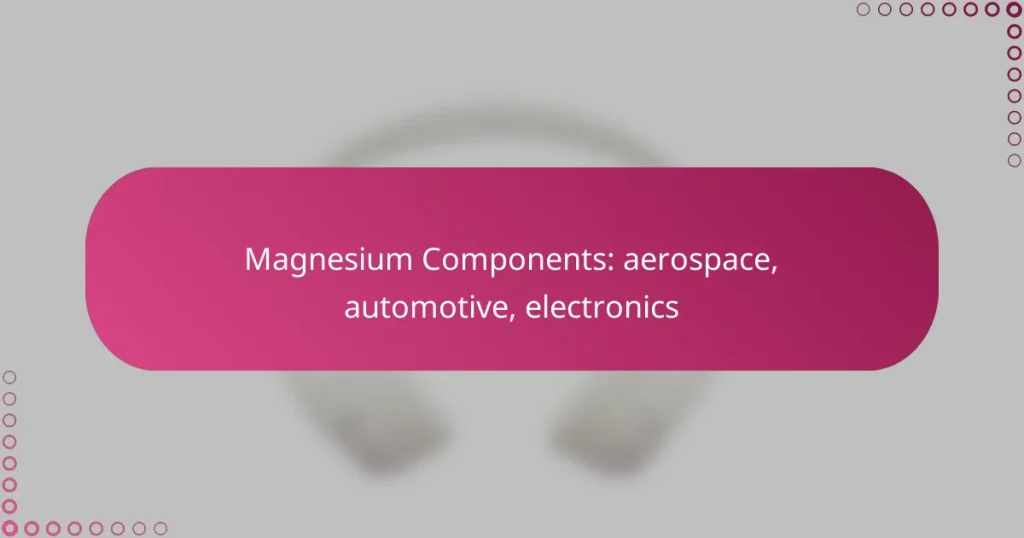Magnesium is a versatile material that plays a crucial role in aerospace, automotive, and electronics industries due to its lightweight properties and strength. In aerospace, it enhances performance and fuel efficiency through its use in structural and engine components. In automotive manufacturing, magnesium helps reduce vehicle weight while ensuring structural integrity, thus improving fuel efficiency. Additionally, in electronics, its ability to dissipate heat and provide electromagnetic shielding makes it an ideal choice for lightweight enclosures and improved device performance.

What are the applications of magnesium in aerospace?
Magnesium is widely used in aerospace for its lightweight properties, which enhance performance and fuel efficiency. Its applications range from structural components to engine parts, contributing significantly to aircraft design and functionality.
Lightweight structural components
Magnesium is ideal for lightweight structural components in aerospace due to its low density and high strength-to-weight ratio. Parts such as aircraft frames, panels, and brackets often utilize magnesium alloys to reduce overall weight, which is crucial for improving flight efficiency.
Common magnesium alloys used in aerospace include AZ31 and AZ61, which offer good mechanical properties and corrosion resistance. These materials help manufacturers meet strict weight requirements while maintaining structural integrity.
Engine components
In aerospace engines, magnesium components are used to enhance performance while minimizing weight. Engine casings, housings, and brackets made from magnesium alloys can withstand high temperatures and pressures, making them suitable for various engine designs.
Using magnesium in engine components can lead to significant weight savings, which translates into improved fuel efficiency and reduced emissions. However, engineers must consider the thermal properties and potential for corrosion when selecting magnesium alloys for these applications.
Fuel efficiency improvements
Magnesium’s lightweight nature contributes directly to fuel efficiency improvements in aerospace applications. By reducing the overall weight of aircraft, magnesium components help decrease fuel consumption, which is a critical factor in operational costs.
For instance, replacing heavier materials with magnesium can lead to fuel savings of several percent over the aircraft’s lifespan. This not only benefits airlines financially but also aligns with global sustainability goals by lowering carbon emissions.

How is magnesium used in automotive manufacturing?
Magnesium is widely used in automotive manufacturing due to its lightweight properties, which enhance fuel efficiency and performance. It is commonly found in various components, helping to reduce overall vehicle weight while maintaining structural integrity.
Body panels and frames
Magnesium is increasingly utilized in body panels and frames to decrease weight without compromising strength. This material can reduce the weight of vehicle structures by up to 30% compared to traditional steel, leading to improved fuel economy. Manufacturers often use magnesium alloys for their excellent corrosion resistance and formability.
Engine blocks
In engine blocks, magnesium serves as a lightweight alternative to heavier metals, contributing to better engine performance and efficiency. Magnesium engine blocks can weigh significantly less than those made from aluminum or iron, which helps in lowering the vehicle’s center of gravity. This weight reduction can enhance handling and acceleration, making it a popular choice in high-performance vehicles.
Suspension systems
Magnesium components in suspension systems provide a balance of strength and reduced weight, which is crucial for vehicle dynamics. By using magnesium in parts like control arms and struts, manufacturers can improve ride quality and responsiveness. Additionally, the lower weight of magnesium helps in reducing unsprung mass, which can enhance traction and stability during driving.

What are the benefits of magnesium in electronics?
Magnesium offers several advantages in electronics, including improved heat dissipation, effective electromagnetic shielding, and the creation of lightweight enclosures. These properties make magnesium an attractive choice for manufacturers looking to enhance device performance and efficiency.
Heat dissipation
Magnesium is an excellent conductor of heat, which allows it to effectively dissipate thermal energy from electronic components. This property is crucial in preventing overheating, which can lead to reduced performance or failure of devices. By using magnesium in heat sinks or chassis, manufacturers can maintain optimal operating temperatures.
In applications where heat management is critical, such as in high-performance computing or power electronics, magnesium can help extend the lifespan of components. Its thermal conductivity typically ranges from 100 to 200 W/m·K, making it a superior choice compared to many plastics and some metals.
Electromagnetic shielding
Magnesium provides effective electromagnetic shielding, which is essential for protecting sensitive electronic components from interference. This shielding helps maintain signal integrity and reduces the risk of data loss or corruption in devices. Magnesium’s ability to block electromagnetic interference (EMI) is due to its conductive properties.
When designing enclosures for electronics, incorporating magnesium can enhance compliance with standards such as FCC Part 15 in the U.S. or EN 55032 in Europe, which regulate EMI emissions. This makes magnesium a practical choice for manufacturers aiming to meet regulatory requirements while ensuring device reliability.
Lightweight enclosures
One of the standout benefits of magnesium is its lightweight nature, which is particularly advantageous in portable electronic devices. Weighing about one-third less than aluminum, magnesium allows for the creation of robust yet lightweight enclosures. This is especially beneficial in industries like consumer electronics, where portability is a key factor.
Using magnesium in enclosures can lead to significant weight savings, often reducing the overall weight of a device by several grams to tens of grams. This reduction not only enhances user experience but also contributes to energy efficiency, as lighter devices typically consume less power during operation.

What are the key properties of magnesium alloys?
Magnesium alloys are lightweight materials known for their unique combination of properties, making them suitable for various applications in aerospace, automotive, and electronics. Key characteristics include excellent corrosion resistance, a high strength-to-weight ratio, and good thermal conductivity.
Corrosion resistance
Magnesium alloys exhibit moderate corrosion resistance, which can be enhanced through surface treatments such as anodizing or applying protective coatings. These treatments help prevent oxidation and extend the lifespan of components in harsh environments, particularly in automotive and aerospace applications.
In practice, the corrosion resistance of magnesium can vary significantly based on the alloy composition and environmental conditions. For example, alloys with higher aluminum content generally offer better resistance to corrosion, making them preferable for outdoor applications.
High strength-to-weight ratio
One of the standout features of magnesium alloys is their high strength-to-weight ratio, which is often superior to that of aluminum and steel. This property allows manufacturers to create lighter components without sacrificing structural integrity, which is crucial in industries like aerospace where weight savings can lead to improved fuel efficiency.
When selecting magnesium alloys for specific applications, consider the trade-offs between weight reduction and mechanical properties. For instance, while some alloys may be lighter, they might not provide the same tensile strength as heavier alternatives, necessitating careful evaluation during the design process.
Thermal conductivity
Magnesium alloys possess good thermal conductivity, which makes them suitable for applications requiring efficient heat dissipation, such as in electronics. Their ability to conduct heat effectively helps manage temperatures in devices, enhancing performance and reliability.
However, the thermal conductivity of magnesium alloys can vary based on the specific alloy composition. When designing components, it’s essential to assess the thermal requirements and select an alloy that meets the necessary conductivity standards for the intended application.

What factors should be considered when selecting magnesium components?
When selecting magnesium components, factors such as cost-effectiveness and compatibility with other materials are crucial. These considerations ensure that the components meet performance requirements while remaining economically viable.
Cost-effectiveness
Cost-effectiveness is a primary concern when choosing magnesium components, as they can vary significantly in price based on the manufacturing process and market conditions. Generally, magnesium alloys are more affordable than aluminum and titanium, making them attractive for industries like aerospace and automotive.
To maximize cost-effectiveness, consider the lifecycle costs, including manufacturing, maintenance, and potential recycling. For example, components that are lightweight can lead to fuel savings in automotive applications, offsetting initial material costs.
Compatibility with other materials
Compatibility with other materials is essential when selecting magnesium components, especially in applications where they will be joined with dissimilar metals. Magnesium can corrode when in contact with certain metals, so protective coatings or galvanic isolation may be necessary.
In automotive and aerospace applications, ensure that magnesium components are compatible with plastics, composites, and other metals used in the assembly. Conducting thorough material compatibility tests can prevent failures and enhance the overall performance of the final product.


